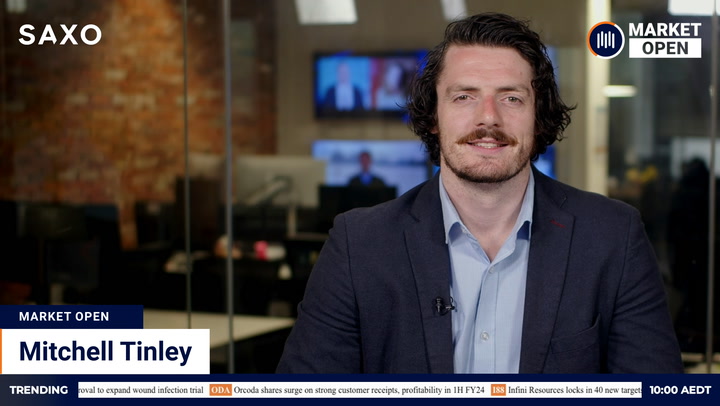Aussie shares were set to open little changed following a flat night on Wall Street and declines in iron ore and crude oil.
US stocks closed mixed as the market neared the end of the worst first-half of a year since 1970. Oil, iron ore and most metals declined. The dollar fell further below 69 US cents.
ASX futures eased one point or 0.02 per cent. The S&P/ASX 200 declined 0.94 per cent yesterday to its first loss in five sessions after a collapse in US consumer confidence raised doubts about corporate profits.
Wall Street
US stocks struggled for direction as GDP data confirmed a slowdown in consumer spending and the Federal Reserve reaffirmed its commitment to raise rates until inflation is under control.
The Dow Jones Industrial Average gained 82 points or 0.27 per cent. The S&P 500 eased three points or 0.07 per cent. The Nasdaq Composite dipped four points or 0.03 per cent.
The major indices traded both sides of break-even as the clock wound down on a challenging month, quarter and first half. The S&P 500 has given up around 20 per cent since the start of the year and is on track for its worst first-half since 1970. The Dow is set for its worst first-half return since the GFC. The Nasdaq’s start to the year is the worst in the history of the index.
“The overwhelming mentality remains gloomy, with most people just trying to avoid bear-market rallies, convinced the SPX has several hundred points of further downside over the coming months,” Adam Crisafulli of Vital Knowledge, wrote.
Final figures for the first quarter showed the economy contracted slightly more than originally estimated. The contraction in gross domestic product was revised down to 1.6 per cent from an initial figure of 1.5 per cent.
Importantly, consumer spending was revised down to 1.8 per cent from last month’s original assessment of 3.1 per cent. Inventories were revised higher, another potential red flag for growth.
The report continued a run of soft data as the Federal Reserve ramps up its war on inflation. Overnight, Chair Jerome Powell reiterated the bank’s commitment to taming inflation at a 40-year high.
“The way to do that is to slow down growth, but ideally keep it positive,” Powell said.
Separately, Fed Bank of Cleveland President Loretta Mester said she would push for a 75 basis point increase in the federal funds rate at next month’s meeting.
“I haven’t seen the kind of numbers on the inflation side that I need to see in order to think that we can go back to a 50 increase,” she told CNBC.
Treasury yields retreated after the GDP report, easing pressure on growth pockets of the market. Apple, Amazon and Microsoft were among the major advances.
Australian outlook
A subdued outlook for the final session of the financial year following an uncertain night on Wall Street. Financial markets look temporarily exhausted by the volatility of the last few months.
A rise in the greenback pushed the dollar down 0.36 per cent to 68.78 US cents and pressured dollar-denominated commodity prices.
This morning’s ASX futures figure looks a tad generous in the light of falls on commodity markets. However, anything is possible as institutional investors try to put the best possible gloss on a difficult year.
Anyone trading at the speculative end of the market will be glad to see an end to this tax loss selling season. The S&P/ASX Emerging Companies Index has fallen 18 per cent this month. That compares to a 7.1 per cent decline for the wider market.
The S&P/ASX 200 has been in repair mode for much of the last fortnight and finished well off its low yesterday. Whether that was genuine buying or end-of-year window dressing remains to be seen.
The sectors that matter most here finished lower overnight in the US. Materials retreated 0.73 per cent. Financials dropped 0.64 per cent.
Energy -3.43 per cent and real estate -0.76 per cent were the worst performers. Bond proxies such as healthcare and consumer staples fared best as bond yields declined. Tech stocks also advanced.
Back home, private-sector credit figures are released at 11.30 am AEST. China announces monthly manufacturing and services-sector surveys at the same time. CSR holds its AGM today.
IPOs: the ASX has Sarytogan Graphite on its ‘Upcoming floats and listings’ schedule for today, but does not give a time. That’s highly unusual and a possible sign the float may not get off the ground this session. The company has a graphite project in Kazakhstan. Another listing originally proposed for today – Chalkos Metals – has been pushed back to July 20.
Commodities
Oil fell for the first time in four sessions as a meeting of the OPEC+ oil cartel got underway without major developments. The group is expected to confirm an increase in output of 648,000 barrels per day from August.
“However, as we have seen in recent months, it is highly unlikely that the group will be able to boost supply by this amount, given the limited spare capacity amongst members and the expectation that Russian oil output will decline as we move closer to the [European Union’s] ban on Russian seaborne crude oil imports,” Warren Patterson, head of commodities strategy at ING, wrote.
Brent crude settled US$1.72 or 1.5 per cent lower at US$116.26 a barrel. The US benchmark eased 1.8 per cent to US$109.78.
Iron ore resumed its slide as part of a broader retreat in commodity prices. The falls came as Chinese talk of economic support failed to develop into specific measures.
“Overall, it seems that the iron ore and steel markets had been trading on the expectation that Beijing would deliver rapid and effective stimulus, especially in the second half of 2022,” Reuters’ Asia commodities and energy columnist Clyde Russell wrote.
“While this may still happen, it appears market participants want to see actual demand rising, rather than officials talking about it.”
The spot price for ore landed at Tianjin eased 17 US cents or 0.1 per cent to US$130.11 a tonne.
BHP‘s US-traded depositary receipts finished unchanged after its UK stock eased 0.21 per cent. Rio Tinto shed 0.52 per cent in the US and 1.01 per cent in the UK.
Gold settled at its lowest level in more than two weeks, pressured by a strengthening greenback. Metal for August delivery settled US$3.70 or 0.2 per cent in the red at US$1,817.50 an ounce. The NYSE Arca Gold Bugs Index gave up 1.1 per cent.
Industrial metals traded mixed on the London Metal Exchange amid questions over demand as the global economy loses momentum. Benchmark copper bounced 0.53 per cent to US$8,409.50 a tonne. Nickel rallied 3.22 per cent and tin 3.66 per cent. Aluminium fell 0.74 per cent, lead 2.13 per cent and zinc 0.6 per cent.





